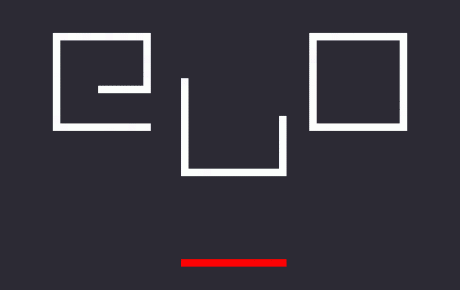"Sea and Spar Between" is a generated poem by Nick Montfort and Stephanie Strickland, published in Dear Navigator in 2010. The poem was republished by The Winter Anthology in 2012. (1) The poem contains approximately 225 trillion two-line stanzas, generated from text pulled from Herman Melville's Moby Dick and the works of Emily Dickinson.
The poem consists of a grid of stanzas in dark blue sans serif font floating on a lighter blue background. Each stanza is assigned coordinates from 0,0 to 14992383, 14992383. One set of coordinates are displayed in white text immediately above the stanza which sits in the center of the screen. Readers can navigate the poem using keyboard commands (space bar and arrow keys) or mouse movements and clicks; readers can also type in specific coordinates to an input box at the bottom center of the screen.
Leonardo Flores has discovered that the coordinates describe a recursive surface, in which 0,0 sits adjacent to 14992383, 14992383. The poem's topography is, he notes, "not a flat mapping with edges, but a circular one with the end looping back to the beginning." (2) Navigating the vast poem thus puts pressure on what it means to have beginnings and endings, to have centers and edges.
As vast as the poem is, the script which creates it, as Montfort and Strickland point out, "is fairly small and simple." The code creating the poem "has fewer characters than the file that implements the vector font." (3) Juxtaposing poem and code reinscribes a boundless/constrained dichotomy located in the source works of Melville and Dickinson.
As the ostensible "beginning" and "ending" stanzas neighbor one another in a regular grid, the poem embraces a certain visual orderliness. Akin to the orderliness, the stanzas also often demonstrate repeated constructions, themes, and spatial relationships. Stanza 0,0, for example, reads
circle on
but artless is the earth
one air one air one air one air
another! again!
The recursiveness suggested by the opening "circle on" is reinforced by the closing imperatives "another! again!" The opening line "on," which simultaneously signals continuation and movement across a surface, in the third line evolves into an insistent "one," initiating themes of unity and identity.
The poem weaves such themes of unity and identity with nature and the elements. The adjacent stanza, 14992383, 14992383, "closes" the poem by repeating most of stanza 0,0. It begins with 0,0's closing lines - "one air one air one air one air another! again!" and it ends with 0,0's gently ambiguous judgement about terra firma - "but artless is the earth." "Sea and Spar Between" thus interlaces Dickinson's preoccupation with the boundaries of the self with Melville's oceanic obsessions. One constantly oscillates between intimacy and remoteness.
The emergence of clear linguistic repetitions in the poem speaks to the ways such structures have informed generated poems since their earliest examples. Christopher Strachey's 1952 "Loveletters," for example, deploys a highly-constrained corpus in the service of exploring desire's mutability or lack thereof. With "Sea and Spar Between," the non-infinite but still vast field created by the poem nevertheless seems to set the stanzas adrift or render them like so many rolling waves, one coming after the other. One can easily lose one's bearings. With the slightest move of the mouse or brush of the keyboard, one's position shifts. Losing the coordinates for a stanza means that, statistically speaking, one will never find that stanza again. The one that gets away, to repurpose the poem's fishy foundations, is irrevocably lost.







